- Quick Read
- Deep Read ( 17 Min. )
Monitor Daily Podcast
- Follow us:
- Apple Podcasts
- Spotify
- RSS Feed
- Download
TODAY’S INTRO
Saudi Arabia, a green energy leader?
 Noelle Swan
Noelle Swan
Today’s lead story almost didn’t happen.
When Taylor Luck, the Monitor’s Middle East reporter, heard that Saudi Arabia was attempting to “go green,” he was intrigued – but dubious.
As the world’s second-largest producer of oil, Saudi Arabia is “often seen as the spoiler to progress on climate,” he says. “It was just kind of hard to believe.”
Some of what he found confirmed his skepticism. The kingdom isn’t giving up its hold of the global oil market – far from it. But at the same time, Taylor saw a nation striving to become a global leader in renewable energy technologies.
Some of that investment is intended to offset emissions associated with continued oil production. But the fruits of the Saudis’ research and development in this sector will inform technological progress in other nations as well.
“Maybe the net-zero carbon equation might not be reached,” Taylor says. “But at the end of the day, I could see that there were real positive steps, and that other people could benefit.”
Out in the countryside, Taylor started to see sprigs of hope beginning to blossom as he toured several reforestation efforts working toward the audacious goal of planting 10 billion trees.
“I have to admit that I went in thinking that they were just going to be importing a bunch of trees and planting them and just walking away,” he says, pointing to similarly bold reforestation efforts that have failed elsewhere.
Yet Taylor met “lifelong tree-huggers” who were tapping into the private seed banks and extensive knowledge of the region’s dynamic ecosystems that they had been cultivating for years.
What’s more, it appears to be working.
Taylor visited a dam that had been built just this winter and found that “one little pool of water” had sprouted trees. Birds and butterflies were already fluttering about this new oasis.
“One thing that really struck me was, even in the arid areas, life can be brought back,” Taylor says. “I think that’s an important lesson: There always is a chance to kind of bring life back, and it comes back very quickly.”
Keep an eye out later this week for a conversation with Taylor Luck about his cover story on the “Why We Wrote This” podcast.
Share this article
Link copied.

Help fund Monitor journalism for $11/ month
Already a subscriber? Login

Monitor journalism changes lives because we open that too-small box that most people think they live in. We believe news can and should expand a sense of identity and possibility beyond narrow conventional expectations.
Our work isn't possible without your support.
A deeper look
Can oil industry address climate change? Saudi Arabia says yes.
The effort to abate climate change has a new player: Saudi Arabia. Yet some doubt the world’s second-largest oil producer will strike the right balance between current needs and future necessities.
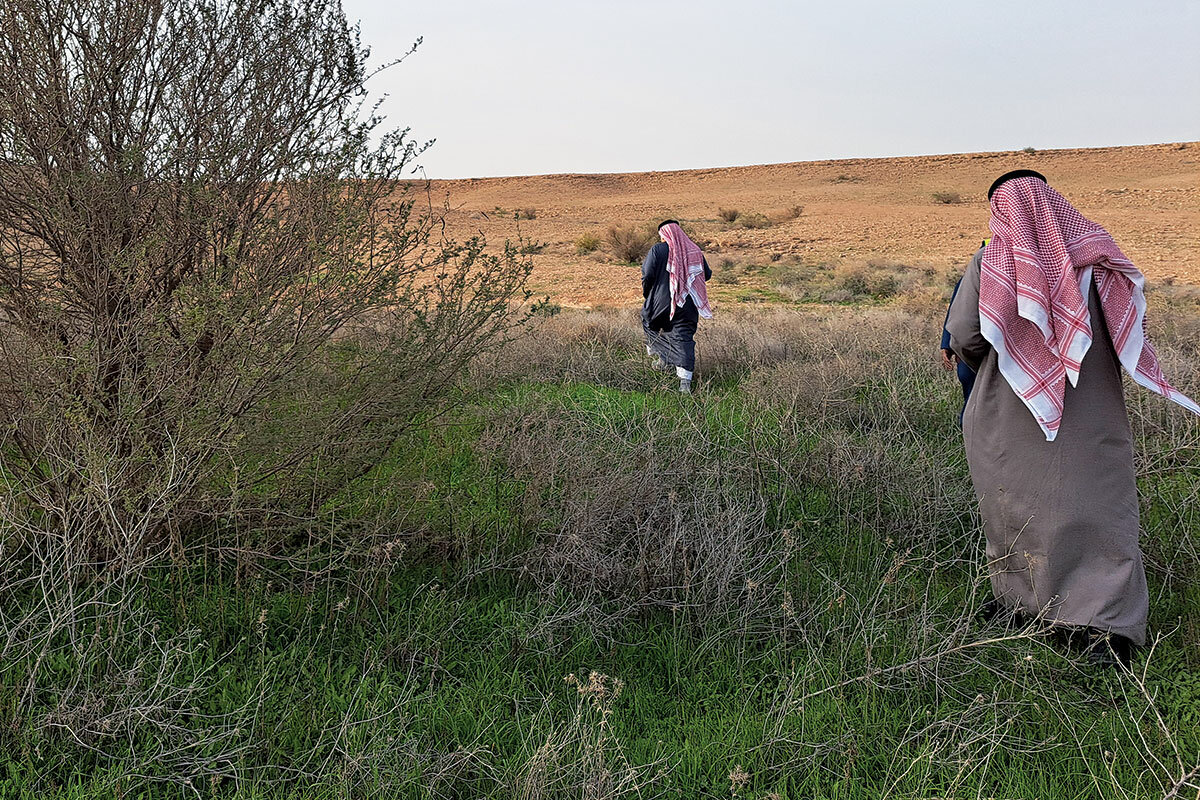
A bustling construction project is not uncommon in Saudi Arabia. But here in Thadiq, in the baking Najd desert north of Riyadh, this grand project is not the start of another gleaming skyscraper. It is something even more audacious: a future forest.
Like most of Crown Prince Mohammed bin Salman’s moonshot plans, the Saudi Green Initiative’s goals are big, bold, and bordering on the impossible: plant 10 billion trees, push the kingdom’s energy mix to 50% renewables by 2030, cut 278 million tons of carbon emissions by the decade’s end, preserve 30% of Saudi land as protected nature reserves, and reach net zero by 2060.
As part of its move toward renewables, Saudi Arabia plans to bring 58.7 gigawatts of solar and wind projects online in the next seven years.
But by no means is the kingdom abandoning oil. On the contrary, it depends on oil demand to fund its ongoing economic diversification, prepare for a post-oil future, and meet its net-zero goals.
Critics call it “greenwashing,” while some climate experts accuse Saudi Arabia of deliberately blurring the narratives around climate change solutions to blunt the campaign to phase out fossil fuels.
“Seeing is believing,” says Noura Alissa, the youngest member of Saudi Arabia’s climate negotiating team. “Don’t judge until you listen to what we are doing with an open mind. Come to us with questions, engage, and then form your opinion on whether or not it is believable.”
Can oil industry address climate change? Saudi Arabia says yes.
A bulldozer and a crane lift barren earth from the ground at breakneck speed as six men in white thobe gowns tied around their waists carefully stack 100-pound slabs of rock in a long, neat row.
A bustling construction project is not uncommon in Saudi Arabia, a country in the grip of rapid economic and social change.
But here in Thadiq, in the baking Najd desert north of Riyadh, the only structure in sight is a 4-foot stone wall. The men work in a flat, exposed, dusty expanse pockmarked with hundreds of neatly dug holes, 4 feet long and 1 foot wide, stretching to the horizon like a battlefield cemetery waiting for the fallen.
This grand project is not the start of another gleaming skyscraper. It is something even more audacious: a future forest.
“Greening needs effort and patience,” Abdullah al-Issa, or Abu Brahim, says as he directs the preparations for planting 30,000 saplings. “When you are doing good work, there is a lot of work to do.”
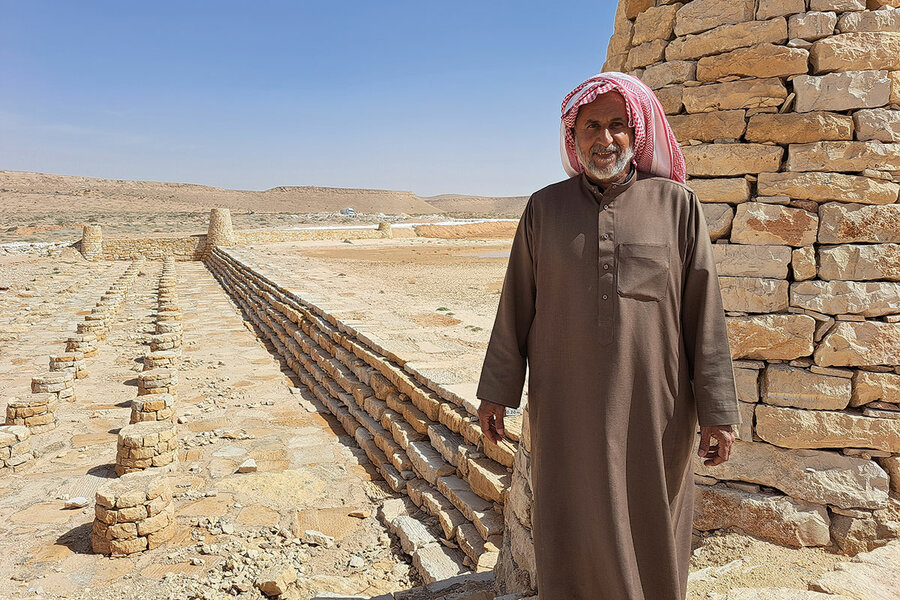
Can a desert turn green – and stay green? Can the world’s second-largest oil producer lead the fight against climate change? Saudi Arabia is saying yes to both – a bold bet whose payoff depends on places like Thadiq and individuals like Abu Brahim.
A Saudi Johnny Appleseed, this middle-aged agricultural engineer with twinkling eyes and a constant smile started planting different saplings and seeds he had accumulated from across the kingdom in these then-barren fields a decade ago in a bid to reverse the desertification encroaching on his hometown.
After his initial success, the Saudi government declared the 220-square-mile area the Thadiq National Park in 2018. Now, with government encouragement and funds, he has planted 170,000 trees and is preparing for the next 100,000.
An Oil Giant Sees Green
Does the promise of a big push into afforestation and renewable energy point to an authentically “greening” Saudi Arabia? To an open quest for an edge in an emerging global market? To both of those things? Our Amman, Jordan-based writer describes the careful listening that went into the reporting of a counternarrative cover story that’s really all about balance and transformation. Hosted by Clay Collins.
On this warm February morning, Abu Brahim has a visitor: Abdullah al-Subeihi, a conservationist and arborist from the country’s National Center for Vegetation Cover (NCVC), the government agency tasked with scaling up greening projects like this one.
“When it comes to forestation, action, not words, matter,” Mr. Subeihi says, admiring the budding red fruits of a 4-foot-tall jujube. “These stunning results are a great sign.”
With four decades’ experience in conservation, Mr. Subeihi is a human library of the trees, shrubs, and flowers native to Saudi Arabia. Squeezing branches, pinching fruits, and gently caressing healthy green leaves, Abu Brahim and Mr. Subeihi geek out over each tree and shrub like gearheads admiring a classic car.
Finally, they arrive at the secret to Abu Brahim’s success: a large rainwater catchment dam, one of 100 in the park. Completed in the summer of 2022, it consists of a series of low-lying stone walls that decrease in height like giant steps down into the valley floor. The design is intended to redirect and slow increasingly frequent winter floods to keep them from tearing up shrubs and saplings and to allow groundwater and aquifers to regenerate.

Two-week-old rainwater collects in a clear lake with young acacia trees sprouting from the center. Pigeons and shrikes hop at the water’s edge, and butterflies float from shrub to shrub. Multiple desert fox and hare sightings have been reported in the park, and Riyadh picnickers have started to gather here on weekends.
“When I started, there were only five trees in this whole area. In my children’s time, this will be a forest that they can take their children to,” Abu Brahim says, leaning his arm on a dam wall. “This is an amazing feeling,” he says, gazing at the acacia trees on the horizon. “This is the feeling of life.”
Planting billions of trees, going solar, capturing carbon from the sky, and a green hydrogen revolution – Saudi Arabia’s declared green transition sounds as fanciful as it is surprising from a fossil-fuel giant.
But few countries in the world have the deep-pocket resources and centralized decision-making like Saudi Arabia to make it happen.
After neglecting climate change action for decades, Saudi Arabia says it is embracing climate solutions and sustainability at every level. But by no means is the kingdom abandoning oil. On the contrary, it depends on oil demand to fund its ongoing economic diversification, prepare for a post-oil future, and meet its net-zero goals.
Saudi Arabia maintains that it can green the Middle East and continue to produce oil and gas in a responsible, low-carbon fashion as the world slowly shifts away from fossil fuels.

Critics call it “greenwashing,” while some climate experts accuse Saudi Arabia of deliberately blurring the narratives around climate change solutions to blunt the campaign to phase out fossil fuels.
Yet with billions of dollars being pumped into afforestation, green hydrogen, and carbon capture and reduction strategies – supported by research, development, and top-down climate edicts from the crown prince himself – Saudi Arabia’s green transition is in full swing in every sector. It’s a green transition funded by oil revenues.
The Saudi Green Initiative (SGI), the brainchild of ruling Crown Prince Mohammed bin Salman, was launched by the crown prince in March 2021 and brought to an international audience of experts and diplomats by Saudi Arabia last November in a specially built domed pavilion on the sidelines of the COP27 climate conference in Sharm el-Sheikh, Egypt.
Like most of the crown prince’s moonshot plans, the Saudi Green Initiative’s goals are big, bold, and bordering on the impossible: plant 10 billion trees, push the kingdom’s energy mix to 50% renewables by 2030, cut 278 million tons of carbon emissions by the decade’s end, preserve 30% of Saudi land as protected nature reserves, and reach net zero by 2060.
But that’s not all. Recognizing the cross-boundary impact of climate change, Saudi Arabia also announced a parallel, regionwide Middle East Green Initiative (MGI).
Without action on greenhouse gases, the Middle East North Africa region is on pace for warming at twice the global rate, with temperatures projected to rise by 4 degrees Celsius by 2050 – along with desertification, dust storms, and the evaporation of the Persian Gulf’s fresh-water resources.
The MGI aims to plant a staggering 50 billion trees across the Middle East, reduce 670 million tons of carbon dioxide regionwide, help neighboring states reach net-zero goals, provide clean cooking fuel for 730 million people, and make Saudi Arabia a regional hub for green hydrogen and carbon-capture technologies.

On paper or spoken by government officials in forums, it may sound like green-friendly spin, declarations that are good for the kingdom’s image that may never be realized.
But the Saudi crown prince’s penchant for moonshots isn’t just a matter of words. Seven years ago, he announced Vision 2030 – building up a non-oil economy and a futuristic 105-mile-long city from scratch. While that deadline may not be met, work on the project has boosted the kingdom’s growing non-oil GDP. Even more attention is being paid to the Saudi Green Initiative, with officials, researchers, innovators, environmentalists, energy experts, and entrepreneurs scrambling to make the green transition as much of a reality as possible – as fast as possible.
When it comes to forestation, many of the SGI’s grand ambitions fall on the shoulders of the 2-year-old National Center for Vegetation Cover.
Last November, this agency of conservationists and arborists was tasked with planting more trees than there are people on Earth.
“This is a great challenge but a welcomed challenge,” says Ahmad al-Anazi, director of the NCVC’s afforestation department. “Everyone from the leadership to the private sector to individual citizens is getting involved in making our country green. ... And we need everyone’s involvement.”
Saudi leadership has also stipulated that greening efforts must employ native species only, reasoning that they can better withstand the weather extremes of Saudi Arabia’s diverse regions – extremes that are expected to intensify with climate change.
The NCVC works with parks, nature reserves, companies, and private citizens to rear saplings of local trees and shrubs in dozens of nurseries before mass plantings. Young trees receive up to three years of assisted irrigation with treated wastewater or rainwater. After that, they’re on their own.

Some of Saudi Arabia’s regions are more obvious choices for greening, such as the mangrove forests along the kingdom’s coasts, expected to make up to 10% of the 10-billion-tree target, or the juniper tree-lined mountainous regions of the south, which receive monthslong rains.
In arid central and northern Saudi Arabia, foresting officials are counting on the construction of rainwater catchment dams to increase groundwater for the dry summer months, when temperatures regularly top 112 degrees Fahrenheit (44 C).
“Desertification and the loss of green cover have long been issues in the kingdom, but before we had no support – it wasn’t a concern,” says Mr. Subeihi, the arborist. “Now we have an incredible budget, we have authority, we have support from the very top on down. We are able to make our dreams a reality.”
To protect the green cover from overgrazing and human misuse, Saudi Arabia has passed laws criminalizing logging and excessive grazing, established a special environment court that fines violators, and is set to reserve 30% of the country’s lands and oceans as protected nature reserves – a stipulation from the crown prince himself.
Saudi arborists know they face skepticism, in part due to the failures of grand afforestation projects elsewhere.
One comparable project, the multibillion-dollar Great Green Wall – a planned 4,000-mile, continent-spanning belt of trees across Africa to combat the encroaching Sahara Desert – was launched in 2007 to much acclaim, but it was never completed due to insufficient funding. Around 80% of planted trees died from lack of water and scorching heat.

One of the lessons Saudi growers are applying from that failure is a constant monitoring of young trees. Afforestation efforts in China, India, and Pakistan have been instructive as well.
On a futuristic-looking campus the size of a small town, scientists, engineers, academics, and oil experts are busy working to perfect carbon capture and utilization technologies, synthetic fuels, and renewable energy generation and storage.
Here at the King Abdullah Petroleum Studies and Research Center (KAPSARC), the same institute that has led Saudi Arabia’s gas and oil technology for three decades is now leading the research behind its green transition.
“Saudi Arabia is going to be a major player when it comes to the energy transition and the way forward,” says Fahad Alajlan, KAPSARC president.
When it comes to developing renewable energy or scaling up carbon-capture technologies and utilizing green hydrogen, “Saudi Arabia wants to be a larger player not only at the domestic level but as a regional hub for some of these industries,” he says, underlining a massive shift in the kingdom’s thinking.
One of the goals is a dramatic move away from Saudi Arabia’s reliance on fossil fuel-burning energy production, with plans to bring 58.7 gigawatts of solar and wind projects online in the next seven years.
The kingdom has 1 GW of solar online now, and several solar “gigaprojects” a year or two away from completion, including solar plants near Riyadh and Mecca.

Another area of Saudi investment is green hydrogen, which the United Nation’s Intergovernmental Panel on Climate Change (IPCC) has highlighted as a complementary low-carbon energy source that can supplement renewable energy sources and be used for industrial heating and to power vehicles, among other uses.
The Neom Green Hydrogen Project envisions a green hydrogen hub near the futuristic Neom city, a planned 100-mile-long city and tourism project in northwest Saudi Arabia, that would power the city, transport, and industry, and potentially provide energy exports.
Plants powered entirely by renewables would utilize solar and wind energy to produce green hydrogen by electrolysis, with four such plants already announced.
The first plant, expected to be online by 2026, is to produce 600 tons of clean hydrogen per day and 1.2 million tons of green ammonia annually, which Saudi energy companies claim will mitigate the impact of 5 million tons of carbon emissions from gas- or oil-based power per year.
Japan and South Korea have already expressed interest in importing future Saudi green hydrogen to power their own transitions away from fossil fuels.

Perhaps the largest pillar of Saudi’s green efforts is carbon capture and storage. These technologies include direct air capture of carbon from the sky, sequestering carbon deep in the earth, and reducing CO2 emissions in industry, transportation, and hydrocarbon production.
The IPCC has highlighted decarbonizing industry and boosting carbon capture and storage as key pathways to reducing emissions and meeting the goal of limiting the Earth’s warming to 1.5 degrees Celsius. However, these strategies remain controversial due to fears among some climate experts that it may be used by oil- and gas-producing countries like Saudi Arabia to continue fossil fuel production, delaying energy transitions.
Yet Saudi decision-makers argue that the international community’s sole focus on a decadeslong shift from fossil fuels is neglecting the other part of the carbon equation – reducing CO2 in current emissions and capturing carbon. After all, they say, the goal of the Paris Agreement is to reduce carbon – not eliminate hydrocarbons themselves, which still remain a major global energy source.
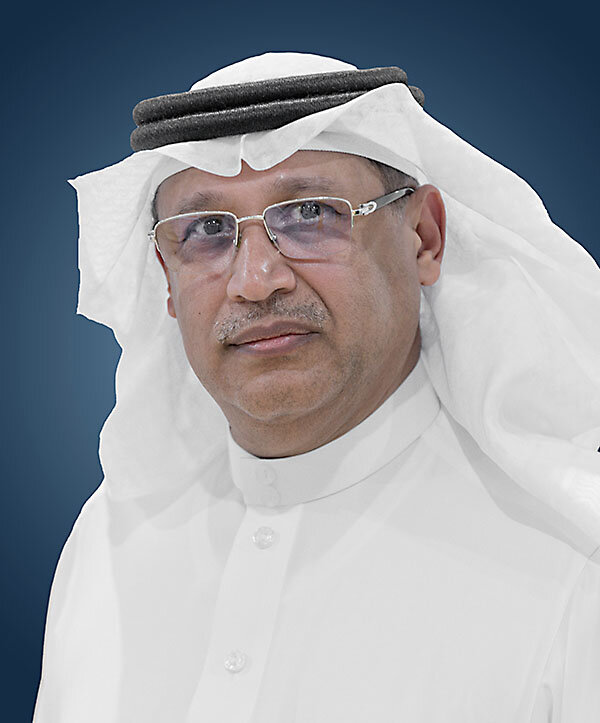
“We really need to deal with hydrocarbons, whether we like it or not, and we need to find ways to utilize [them] cleanly within this decade,” says Khalid Abuleif, chief climate agreements negotiator at Saudi Arabia’s Ministry of Energy.
“We need not only to address renewables, but on the other side we need to ensure carbon dioxide removal to manage inefficiencies that come with renewables. Without managing this side, you will not be able to keep [the] 1.5 goal in reach,” he says.
To that end, Saudi Arabia and Saudi oil giant Aramco announced late last year a carbon capture sequestration hub in Jubail, in eastern Saudi Arabia. By capturing and injecting carbon deep into the ground, the facility is to store 9 million tons of CO2 annually by 2027 – a number Aramco expects to ramp up to 44 million by 2035, the combined capacity of the 35 largest carbon capture facilities across the world today.

The kingdom is also planning a carbon reduction utilization hub in its western provinces that will link to industry.
“Saudi Arabia wants to be a big part of the supply chain of these technologies,” notes Mr. Alajlan of KAPSARC.
The kingdom is pitching these carbon and emissions reduction processes as a comprehensive system it calls the circular carbon economy. The CCE is named after the “circular economy” concept built on the three R’s: reduce, reuse, and recycle goods. Under the Saudi concept, the goods in question are hydrocarbons, and they add a fourth R: remove, as in remove CO2 .
Saudis say the overall goal of the CCE is to reduce carbon by utilizing renewables, energy-efficient processes, and green hydrogen; reuse hydrocarbons and recycle them into new materials such as fertilizer or synthetic, low-carbon fuel; and then remove CO2 emitted in the process through direct air capture or sequestration and nature-based solutions such as planting trees.
Through a circular carbon economy, Saudis claim economic growth can continue in what they describe as a closed carbon loop, with net-zero carbon emissions. The G-20 nations endorsed the concept in 2020.
Saudi Arabia’s billions of dollars of investment in the field are a “big commitment that can have an overall impact on the availability of carbon capture and storage” technologies for other countries, notes Angela Anderson, director of Industrial Innovation and Carbon Removal at the World Resources Institute’s climate program. Experts cautiously welcome the kingdom’s push for renewables.
But climate and sustainability experts have big questions.
Namely: Will carbon-reduction technologies accelerate or delay the clean energy transition?
“If Saudi Arabia and other oil-producing nations use carbon capture and storage to reduce their emissions in the short term while they transition away from fossil fuels like the rest of the world, I think that can be a very positive development,” says Ms. Anderson. “But if they do it in a way that continues to block progress towards the move away from fossil fuels, that would be devastating.”
In short, despite their benefits, carbon reduction and capture technologies alone are no substitute for phasing out fossil fuels, climate experts warn. Their use should be alongside low-carbon energy sources, not fossil fuels, they say.

“What is clear is that we cannot continue with the level of fossil fuels Saudi Arabia is producing and the world is consuming at the moment,” says Mia Moisio, Middle East and North Africa expert at the NewClimate Institute, a Germany-based nonprofit. “There will be no other way out except reducing oil and gas production and consumption.”
But Saudi Arabia is undeterred; it is planning a regional carbon capture economy knowledge center to share their know-how and technologies with other countries.
IF THE NET BENEFITS of Saudi Arabia’s green transition are yet to be clear, the impact on the business culture of a kingdom built on oil is immediately apparent.
On the sidelines of a session at an International Association of Energy Economists conference held at KAPSARC’s campus in February, a senior Aramco executive had one simple piece of advice for an aspiring young Saudi petrochemical engineer: “Sustainability and climate,” he told him. “If sustainability and climate are not part of your work and research, you have no future.”
As Aramco pours billions into carbon dioxide removal technology, plants mangroves, and establishes wildlife reserves, hundreds of non-oil Saudi companies are embracing sustainability and climate as a core part of their mission statements.
Princess Noura bint Turki al-Saud is one of the kingdom’s leading sustainability development consultants. Her Riyadh-based company Aeon Strategy assists clients ranging from Saudi government agencies to small startups in adopting environmentally sustainable practices such as energy efficiency and the use of renewables and low-carbon materials.
“What we are doing in Saudi Arabia is striking the balance of green and economic diversification,” she tells the Monitor.

“People are stuck with this thought that ‘oil is bad. You are an oil producer; therefore, there is no way you can contribute to preserving the environment, let alone address climate change.’ But, in fact, it is being embraced,” she says.
The investment funds, pro-business laws, incubators, and ecosystem Saudi Arabia has put in place the past five years to nurture and boost startups and tech firms are being used by young Saudis to launch green businesses promoting solar windows, net-zero fertilizer, net-zero greenhouses, and more.
“The announcement of the Saudi Green Initiative made young Saudis excited that there is more to be done about sustainability than planting a tree or throwing away a plastic bag,” says Princess Noura.
One of those young Saudis is Noura Alissa. At the age of 26, she is the youngest member of Saudi Arabia’s climate negotiating team and serves as senior international policy analyst for climate change at the Saudi Ministry of Energy.
She has one response to Saudi Green Initiative skeptics.
“Seeing is believing,” Ms. Alissa says. “Don’t judge until you listen to what we are doing with an open mind. Come to us with questions, engage, and then form your opinion on whether or not it is believable.
“The kingdom makes announcements with complete transparency and is open to being scrutinized against those announcements – because, at the end of the day, this progress is what we can show for net zero.”
One place that started receiving visitors in February is the recently formed King Salman Nature Reserve in northern Saudi Arabia, a reserve the size of Greece, or 6% of the kingdom’s landmass.
Visitors are invited to plant 20 trees in lieu of paying yearly camping and entry fees, and solar panel stations dot the reserve. It also borders Saudi Arabia’s largest photovoltaic solar power plant in Sakaka.
About 250 miles southeast of the reserve, Mr. Subeihi of the NCVC is finishing up his daily rounds at the Al Ghat National Park, yet another private initiative by a retired agricultural engineer, Suleiman al-Saoub, that is being scaled up by the Saudi government.
Without assisted irrigation, in an area of 13 square miles fenced off from grazing camels and sheep, Mr. Saoub has managed to plant 200,000 trees in 15 years, transforming the dusty area into green cover as thick as 150 trees per acre.
Five-year-old red acacia trees, 7 feet tall, extend from thick stretches of lush green grass and boxthorn shrubs at the edge of bleak, yellow, rocky desert. Here two entirely different habitats collide, a meeting point of parallel universes – the old Saudi Arabia and, if Saudi leaders get their way, the new.
Leaving the park, Mr. Subeihi suddenly tells the driver to pull over. He gets out and practically sprints up a barren hill.
There, in an imprint in the dirt, spindly acacia branches – several inches long with new, green leaves – push out from the soil. This is not a man-dug trench, and this sapling was not planted. It is a naturally occurring tree. A seed carried by winds landed in this spot and grew in soil damp from winter rains, thriving without human intervention.
“This is what we dream and work for – a self-generating and regenerating ecosystem,” Mr. Subeihi says as he crouches down, pinching the thin but firm branches.
He asks the reporter to take a photo of him and his find, proof that “with patience, the desert can become green again.”
Editors's note: The timing of the launch of the Saudi Green Initiative has been clarified.

Drafted at the DMV? Military conscription goes digital in Russia.
Russia is integrating its military draft with its digitized, pervasive bureaucracy. That could make new mobilizations for its war in Ukraine more efficient – and much harder to evade.

- Quick Read
- Deep Read ( 5 Min. )
If the Kremlin decides to mobilize more troops to fight in Ukraine, draftees may receive their notices while doing mundane tasks like registering their car.
Under a new law signed by President Vladimir Putin last month, potential recruits can be called up through the popular state services network, which most Russians use to obtain their most basic documents, from driver’s licenses to death certificates.
Some observers see the coming of a “digital gulag” in which every element of life will be overseen, recorded, and, if necessary, punished. Many fear the haste in implementing the new system foretells that another wave of mobilization is in the offing.
The government denies any intention to launch a fresh mobilization for the Ukraine war. Even so, the permanent institutionalization of a modern, highly efficient database of Russian men of military age bespeaks a new official attitude that Russia needs to prepare for a long-term confrontation with the West.
“We are approaching a state of digital authoritarianism, of total control all around. With this new draft system, we are almost there,” says Andrei Kolesnikov, an expert with the Carnegie Russia Eurasia Center. “You can easily see the broader applications, beyond the military draft. The sphere of private life is shrinking.”
Drafted at the DMV? Military conscription goes digital in Russia.
In Russia, it used to be that to get called up for military service, an eligible recruit had to be issued a draft summons in person. Not anymore.
Under a new law rushed through the State Duma with almost no publicity and signed by President Vladimir Putin last month, potential recruits can be called up through the popular Gosuslugi network, a heavily digitized state services bureaucracy that most Russians use to obtain basic documents, from driver’s licenses to death certificates.
Some observers perceive the coming of a “1984”-like total surveillance society, a “digital gulag” in which every element of life will be overseen, recorded, indexed, and, if necessary, punished. Focusing on the military implications, many fear the haste in implementing the new system foretells that another wave of mobilization is in the offing, perhaps as early as September.
The government denies any intention to launch a fresh mobilization of manpower for the Ukraine war. Even so, the permanent institutionalization of a modern, highly efficient database of the estimated 25 million Russian men of military age who are eligible for call-up bespeaks a new official attitude that Russia needs to prepare for a long-term confrontation with the West that is likely to outlast the current conflict in Ukraine.
“We are approaching a state of digital authoritarianism, of total control all around. With this new draft system, we are almost there,” says Andrei Kolesnikov, an expert with the Carnegie Russia Eurasia Center who is still working in Moscow. “Potential military recruits will now need to fear being caught by cameras in the metro, or by visiting a doctor, or almost any public activity. You can easily see the broader applications, beyond the military draft. The sphere of private life is shrinking. ... Putin and his elites are preparing people for a longer and wider war. They don’t hide this.”
Clarifying the system?
The breakneck effort to digitize military lists was prompted by the pandemonium that attended last September’s announcement of a partial mobilization of 300,000 men to bolster the ranks of Russia’s troops in Ukraine after a series of military setbacks last summer.
Russia had not conducted such a mobilization in over 40 years and the indiscriminate methods of ham-handed bureaucrats trying to implement the order triggered social panic. Hundreds of thousands of military-age men fled the country, though many have since returned. Large numbers who weren’t even eligible for the limited mobilization that the Kremlin had outlined were scooped up by military recruiters, disrupting their lives. Even though most were later released by the courts, the social scars remain livid.
Even some anti-war activists say the digital draft system is a rational step that would limit the social trauma of conscription and mobilization by clearly identifying those who are subject to call-up and letting everyone else breathe easy.

“This law would be fine, if not for the war,” says Vadim, a consultant with the Russian Movement of Conscientious Objectors who doesn’t want his family name used. “There was disorder in the military registry, and now the state is imposing order, albeit in a tough and forceful manner.”
He compares it to paying taxes. The rights and obligations of the citizen should be spelled out clearly, as well as the penalties for disobeying. In the military context, Russian law provides the right of a citizen to perform alternative service instead of being drafted into the army. If that right were encoded, and respected, it would clarify each citizen’s choices, he says.
Last year more than 1,000 men were prosecuted for draft evasion in Russia, far more than in any previous year. But Vadim says that none of the conscientious objectors backed by his movement has so far been punished by authorities.
“For us, we don’t oppose the system on principle, although against the background of war, it looks monstrous. We’ll be monitoring it to see how it’s implemented in practice,” he says. “That’s what matters.”
No more evasion
The new system aims to cut down on draft evasion by identifying and locating the person with a variety of high-tech means. It will track potential recruits by integrating with all existing government and law enforcement systems, including medical records, tax records, and street cameras with facial recognition.
Once a draft notice is issued via the Gosuslugi network, the onus will be on the recruit to report within 20 days. Anyone who fails to show up will be barred from leaving the country and banned from using virtually all state services. They will even be barred from driving a car.
Sergei Markov, a former Kremlin adviser, says it’s just a long-overdue modernization of an antiquated system.
“The unplanned mobilization last September led to a lot of well-known problems, most of which were totally avoidable,” he says. “So Putin gave the order to remake that old system, which was last updated in the 1960s, and make it suitable for the coming decades. This should work not only to simplify conscription and possible mobilization, but for a range of other things, such as natural disasters. ... You can call it a ‘digital gulag’ all you like, but in a few years this is going to be happening everywhere. Every viable society is going to be doing this. It’s a database of all the people. That improves the delivery of state services for all purposes.”
Mr. Markov denies that the haste in implementing the new draft system indicates that a fresh wave of mobilization is in the offing. He says the Kremlin has decided, for now, to rely on volunteers to replenish the ranks. It recently launched a massive new advertising campaign aimed at inducing young men to sign up.
That softer approach to raising manpower could be due to sensitivity about public opinion, which may not be as solidly behind the war as opinion polls suggest. Mr. Kolesnikov points out that presidential elections are due in 2024, and Mr. Putin may wish to see some kind of conclusion to the war before then.
“Society can become overburdened by authorities’ actions, though it’s hard to predict the breaking point,” Mr. Kolesnikov says. “Putin is preparing for elections. He may not be willing to repeat past mistakes. Perhaps mobilization will occur, but not so openly as before.”
But the “digital draft” is being put in place very rapidly. Mr. Markov says that’s in case Russia fails on the Ukrainian battlefield in the next few months. If not, the system will be a permanent fixture of Russian life to serve the state in any future emergency that arises.
“These are preparations for living in a dangerous world,” he says. “Everyone is talking about Ukrainian offensives. If they succeed, Russia’s response will be total mobilization, and this is part of that short-term calculation. Otherwise, we know that Russia is going to be in a state of confrontation with the West for many years to come, so we need to start preparing for that.”

In Sweden, recycled fabrics turn old clothes into new fashion
To address the fashion industry’s rampant waste problem, innovators are processing old clothes into brand-new textiles – inspiring both clothing brands and consumers who care about environmental sustainability.

- Quick Read
- Deep Read ( 5 Min. )
Fashion is a trillion-dollar industry notorious for its negative toll on the planet. But companies like Renewcell in Sweden are offering industrial-scale textile recycling technology as a new solution.
Most of what the fashion industry produces ends up as waste. Global production of textile fibers and all apparel creates 110 million metric tons of waste. On average, Europeans produce 33 pounds per year per capita, and Americans about 70 pounds per year.
Solutions range from reducing overproduction and overconsumption to making longer-lasting clothes and embedding circularity into product design. But experts consider fiber-to-fiber recycling – converting textile waste into new fibers that can be used to make textile goods – as both one of the most sustainable and scalable levers available.
That’s what Renewcell does, by breaking down old clothes into its patented material Circulose, which can be spun into new fabric. Circulose has been snapped up for use by major fashion brands including Levi Strauss & Co., Zara, and H&M (which is also an investor in Circulose).
“From an environmental perspective, it means that every year, instead of huge swaths of forest being cut down, millions of old jeans and T-shirts are being used rather than them degrading into methane,” says Nicole Rycroft, director of the environmental nonprofit Canopy.
In Sweden, recycled fabrics turn old clothes into new fashion

Discarded, sorted clothes arrive by ship on the shores of Sundsvall, in the Gulf of Bothnia inlet of the Baltic Sea. But they aren’t bound for a landfill.
Rather, they are destined for the city’s Renewcell plant, where they will be dissolved and processed into a new substance: Circulose. This material looks like white cardboard, feels like watercolor paper, and – most importantly – can be spun into yarns for textile manufacturers.
Fashion is a trillion-dollar industry notorious for its negative toll on the planet. But Renewcell’s patented technology, now available commercially, and successful launch of the world’s first industrial-scale textile recycling plant in Sweden offer a beacon of hope to brands and consumers who care about environmental sustainability.
“From an environmental perspective, it means that every year, instead of huge swaths of forest being cut down, millions of old jeans and T-shirts are being used rather than them degrading into methane in landfill,” says Nicole Rycroft, director of the environmental nonprofit Canopy.
Fashion’s environmental cost
The fashion industry relies primarily on three fibers – polyester, cotton, and viscose rayon – each of which is problematic for the environment.
Polyester, made from plastic, takes hundreds of years to break down. Microfibers from clothes account for as much as 32% of the microplastics polluting the ocean, according to the European Environment Agency, and are also abundant in the air we breathe.
Soft-to-touch cotton is grown on vast, water-intensive monoculture farms using large quantities of fertilizers and pesticides. The Aral Sea, once the world’s fourth-largest lake, dried up almost completely, drained by cotton fields in Uzbekistan and Kazakhstan. One cotton shirt requires 2,700 liters (713 gallons) of water to produce – as much as a person drinks in 2.5 years.
Viscose rayon is made from tree wood, which sometimes comes from ancient forests. Ms. Rycroft points to the 300 million trees cut down yearly to make viscose rayon, among other textiles. That consumption is slated to double within the next decade.
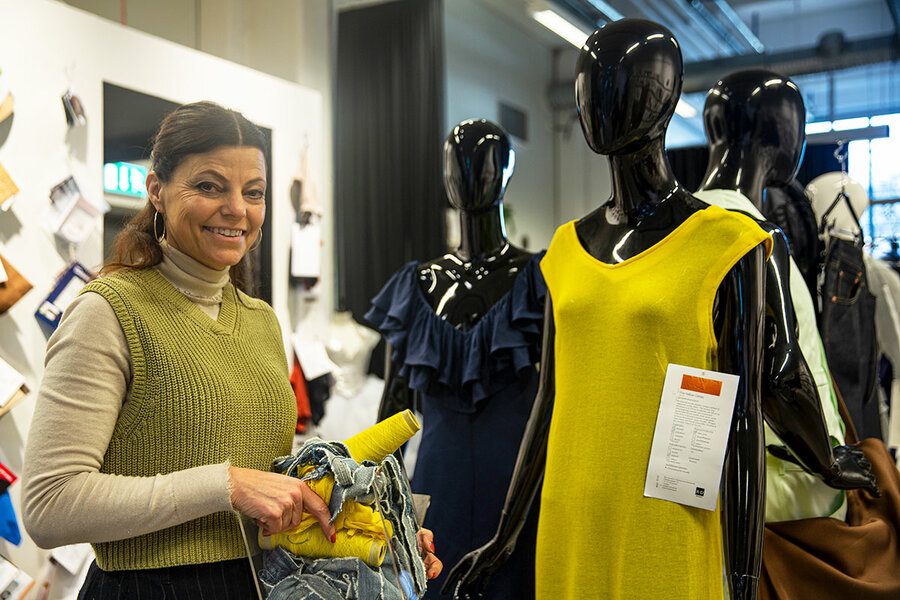
On top of all this, much of what the fashion industry produces with these materials ends up as waste. Global production of textile fibers and all apparel creates 110 million metric tons of waste. On average, Europeans produce 33 pounds per year per capita, and Americans about 70 pounds per year.
Solutions for controlling fashion’s consumption rate range from reducing overproduction and overconsumption to making longer-lasting clothes and embedding circularity into product design. But experts consider fiber-to-fiber recycling – converting textile waste into new fibers that can be used to make clothes or other textile goods – as one of the most sustainable and scalable levers available.
“Textile-for-textile recycling is at an inflection point,” says Jonatan Janmark, a textile sustainability expert and co-author of a 2022 report for McKinsey, a consultancy, on textile recycling in Europe. “There have been 10 to 15 years of quite intense research and development on textile recycling or sustainability in textiles as the industry has come under more pressure,” he says.
Renewcell’s patented new material, Circulose, has been snapped up for use by major fashion brands including Levi Strauss & Co., PVH (which owns Tommy Hilfiger and Calvin Klein), Zara, and H&M (which is also an investor in Circulose). And many promising technologies are transitioning from the research and development stage to commercialization besides Renewcell’s, Mr. Janmark notes.
In the field of cotton, which accounts for 25% of global fiber volume, other players include Infinited Fiber and Spinova in Finland or Circ in the United States. Another dozen companies or so are working on polyester-to-polyester solutions.
The Nordic approach to clothes
The Nordics stand out in Europe for their efforts to reduce the fashion industry’s impact on the planet. Copenhagen Fashion Week imposes sustainability requirements on brands before they hit the runway. Multiple Nordic brands offer recycling options and sell used clothes on their shelves at reduced prices.
Sweden boasts an impressive secondhand clothes market scene; the world’s first recycling mall, Retuna; and innovative companies like Nudie. Nudie offers customers free repairs on their jeans and a 20% discount on new ones if they trade in old ones. It’s a much-loved service.

“I really like clothes, but I don’t think it’s necessary for me to buy something new to get the kind of clothes that I like to wear,” says Tomas Persson after bringing his jeans in for repair to the Nudie shop in Gothenburg. Apart from underwear, he says has not bought a new item of clothing in years – not an uncommon claim in Sweden.
The development of sustainable textiles is also part of Sweden’s national strategy. That keeps the Swedish School of Textiles and Science Park Borås, both part of the University of Borås, abuzz with the development of high-tech prototypes and design experiments focused on recycling, reuse, and upcycling.
“We have to find more efficient production processes ... and ways of consuming garments,” says Susanne Nejderås, textile strategist at Science Park Borås. “The mean use of a clothing item is around two years. We need to add another eight years to that.”
Demands for sustainability
Starting in 2025, the European Union will require all member states to separate textile waste for recycling purposes. “That’s a big challenge,” Ms. Nejderås says. “Maybe the local authorities will have to take care of it, but some parts will have to be paid by the producers.”
Mr. Janmark of McKinsey says the EU legislation will have an international ripple effect. Since many fashion brands are global, they will have to abide by EU law, and that likely means more sustainable processes will spread to other parts of the world. The textile recycling value chain could bring Europe 1.5 billion to 2.2 billion euros in profits by 2030, he says.
Already struggling to keep up with demand, Renewcell projects rapid growth. By 2024, the company wants to double production from 60,000 tons of Circulose per year to 120,000 tons, the equivalent of 600 million T-shirts per year.
Renewcell CEO Patrik Lundström sees consumer demand rather than regulation as the main driver of change.
“We want to eat sustainably, we want to travel sustainably, we want to live in sustainable houses, but we also want to clothe ourselves sustainably,” he says. “Especially the younger generations, they pretty much demand sustainability from the companies that they buy garments from.”

Points of Progress
How the World Bank reformed and Brazil curbs illegal gold
In our progress roundup, efforts to protect people who have less power range from Brazil’s ID process for illegally mined gold, to World Bank reforms that acknowledged the voices of people the bank meant to help.
-
By Ali Martin Staff writer
How the World Bank reformed and Brazil curbs illegal gold
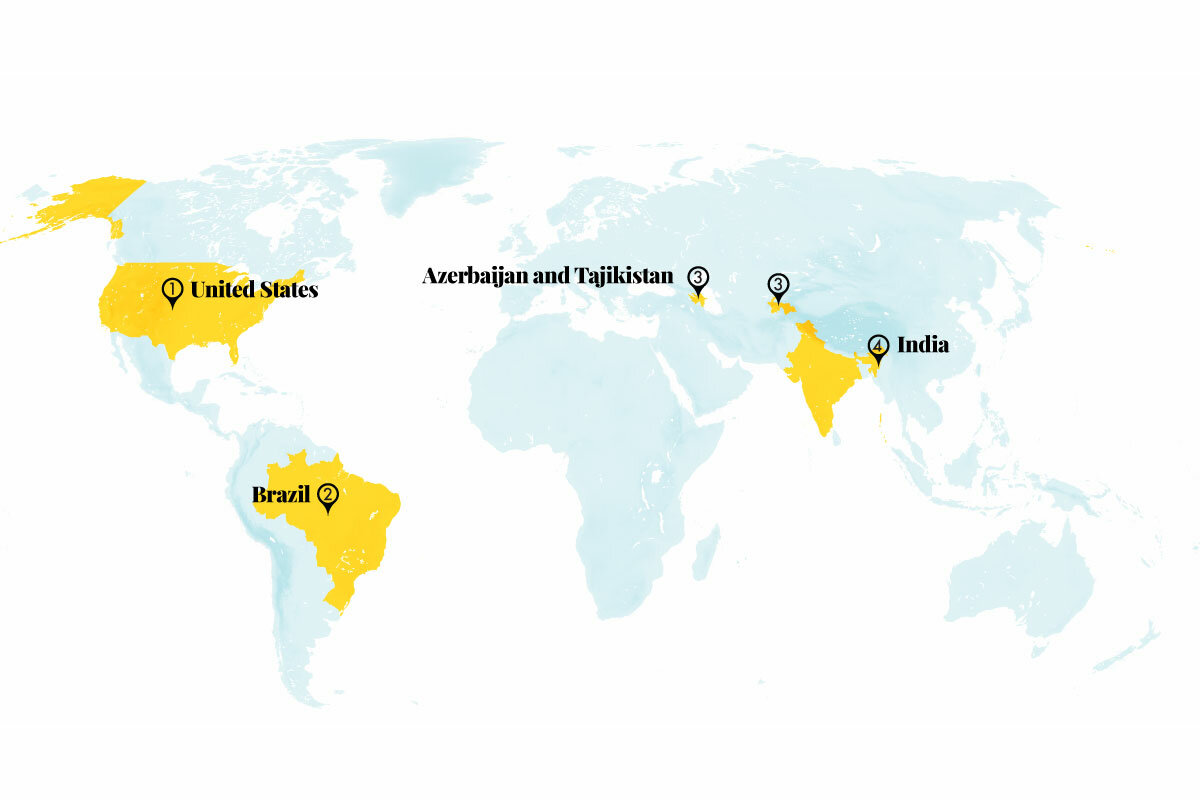
1. United States
A recent study answers a critical question about moon exploration: Where is the water? Scientists examined data from the now-retired Stratospheric Observatory for Infrared Astronomy, a partnership of NASA and the German Space Agency, which showed them how water is moving across the moon’s surface.
By tracking water’s unique light signature, researchers have been able to piece together a detailed map of water distribution on the Earth-facing side of the moon’s south pole region.
Experts have known for over a decade that water exists on the moon, but the study reveals lunar water in colder, shadier places such as crater rims. Scientists continue working toward understanding where the water comes from.

Humans have not landed on the moon since the 1972 Apollo 17 mission. The VIPER rover will study the moon’s south pole next year, and Artemis III is scheduled to land a four-person team including the first woman and first person of color on the moon in 2025. Understanding lunar water could be critical toward the goal of establishing a long-term presence on the moon.
Sources: The Planetary Science Journal, NASA
2. Brazil
A “gold library” is aiding efforts to crack down on illegal mining in the Amazon. The Ouro Alvo program established a database of gold samples from throughout the 1.2 billion-acre forest. With the samples, experts are able to determine unique characteristics of the metal from different mining regions, which allows authorities to confirm illicit hauls.
For decades, “wildcat” mining has wreaked havoc on the environment and Indigenous people, which was hastened by friendly policies of previous President Jair Bolsonaro. One study estimates half the gold – 229 tons – produced and exported from Brazil between 2015 and 2020 was “of dubious origin.” In northern Brazil’s Yanomami Indigenous territory alone – where no commercial activity is allowed – an estimated 20,000 illegal gold miners are at work. Mining there destroyed 1,782 hectares (4,403 acres) last year, a 54% increase over 2021.

In 2020 the database was used to help Brazilian officers seize 77 pounds of gold – worth around $2 million – from alleged smugglers traveling to New York. To increase transparency in the gold market, experts recommend data sharing across agencies.
Mongabay, Reuters, NBC News
3. Azerbaijan and Tajikistan
The World Health Organization has certified Azerbaijan and Tajikistan free of malaria. Public health programs employed insecticides, bed nets, and health worker education. Water-intensive agriculture required years of improvements to irrigation systems and interventions like mosquito-eating fish. Azerbaijan last had a case of malaria in 2012. Tajikistan saw its last case in 2014.
WHO initiatives begun in 2017 and 2021 have targeted 46 countries for malaria elimination. A preventable disease spread through mosquitoes, malaria remains a significant challenge especially in sub-Saharan Africa, where deaths of children under 5 contribute two-thirds of the more than 400,000 malaria-related deaths annually. WHO officials stress the importance of continued surveillance and funding to maintain elimination of the disease.
“Their accomplishment is further proof that, with the right resources and political commitment, eliminating malaria is possible,” said WHO Director-General Tedros Adhanom Ghebreyesus.

Azerbaijan and Tajikistan join 40 other countries or territories in being declared malaria-free.
Sources: World Health Organization, Washington Post
4. India
Some 350 villagers in the Himalayas have stable electricity, thanks to India’s first solar-hydro power system. The pumped-storage facility is built on a stream in the village of Hengbung, where the upper reservoir releases water to a turbine below. Solar-powered pumps send the water back up.
The Himalayas provide almost half of the hydropower installed capacity in India, a source the country plans to expand. But outside of Hengbung in the mountainous states, damage to homes and the environment that opponents say is caused by much larger hydropower projects is prompting protests.
Hengbung residents say their much smaller system is reliably supplying power during outages and periods of high demand. While bad weather and landslides cause transmission line and transformer problems here, excess power can feed the grid during monsoons.
Locals were trained to maintain and troubleshoot their facility. “The system is in our hands now; we can run and maintain it ourselves,” said poultry farmer Romi Rai.
Sources: Context, The Diplomat
World
The World Bank is marking the 30th anniversary of an accountability system that has influenced financial institutions around the globe. In response to protests that called attention to social and environmental damages of World Bank-funded initiatives, the World Bank established its independent three-person Inspection Panel in 1993. The panel investigates complaints from community members and provides a vehicle for redress if a project causes harm.
For example, a forestry project in the Democratic Republic of Congo was revised in 2008 to allow local Pygmies to occupy ancestral lands and manage forests using traditional methods. To date, the panel has taken up 164 cases, 28% of which stem from Africa, 22% from South Asia, and 19% from Latin America and the Caribbean. Issues raised include involuntary resettlement, economic development, environmental health and safety, natural habitats, and cultural resources.
Some 25 international financial institutions have since established their own independent accountability mechanisms, which provide compliance audits and resolve disputes. More than 1,800 citizen-led complaints have been filed with these IAMs.
Sources: The Conversation, The Accountability Console, World Bank
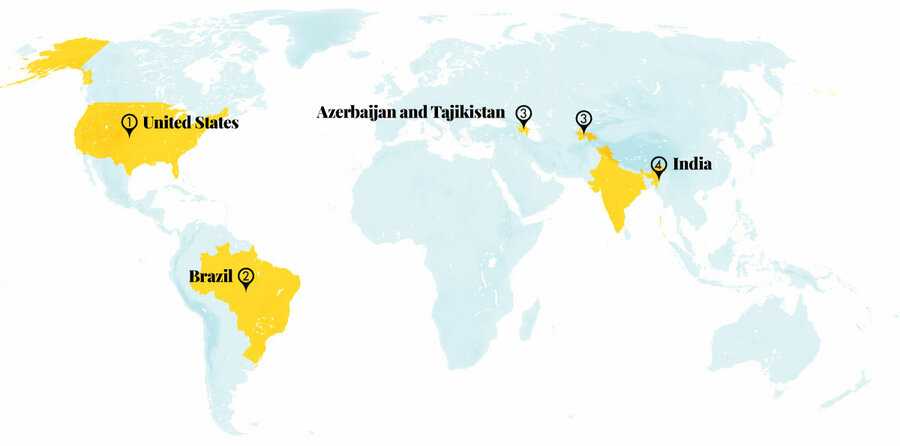
Other headline stories we’re watching
(Get live updates throughout the day.)The Monitor's View
A victory in Europe for clean governance
- Quick Read
- Deep Read ( 2 Min. )
-
By the Monitor's Editorial Board
Bulgaria ranks as the poorest country in the European Union. In civic spirit, however, the Black Sea nation may be displaying new wealth. Three years after mass protests for clean governance, the two largest parties agreed Monday to form a government that, according to reformist politician Kiril Petkov, will have “ministers who will work for Bulgaria without stealing.”
A rising sentiment among Bulgarians in favor of clean leadership has yet to be reflected in many concrete reforms. Five elections in two years revealed the sticking power of a corrupt elite. To achieve political stability after the last election in April, the new government will employ a novel compromise: A leader of an anti-graft party will be prime minister for nine months; then a center-right party long trying to appear to be anti-corruption will hold the premiership.
“The Bulgarian people,” writes Hugo Blewett-Mundy of the Center for European Policy Analysis, “have lost their patience with what they see as a state captured and controlled by an oligarchic mafia.” Their own shift in values – toward transparency and honesty in government – may now be front and center for a new set of leaders.
A victory in Europe for clean governance
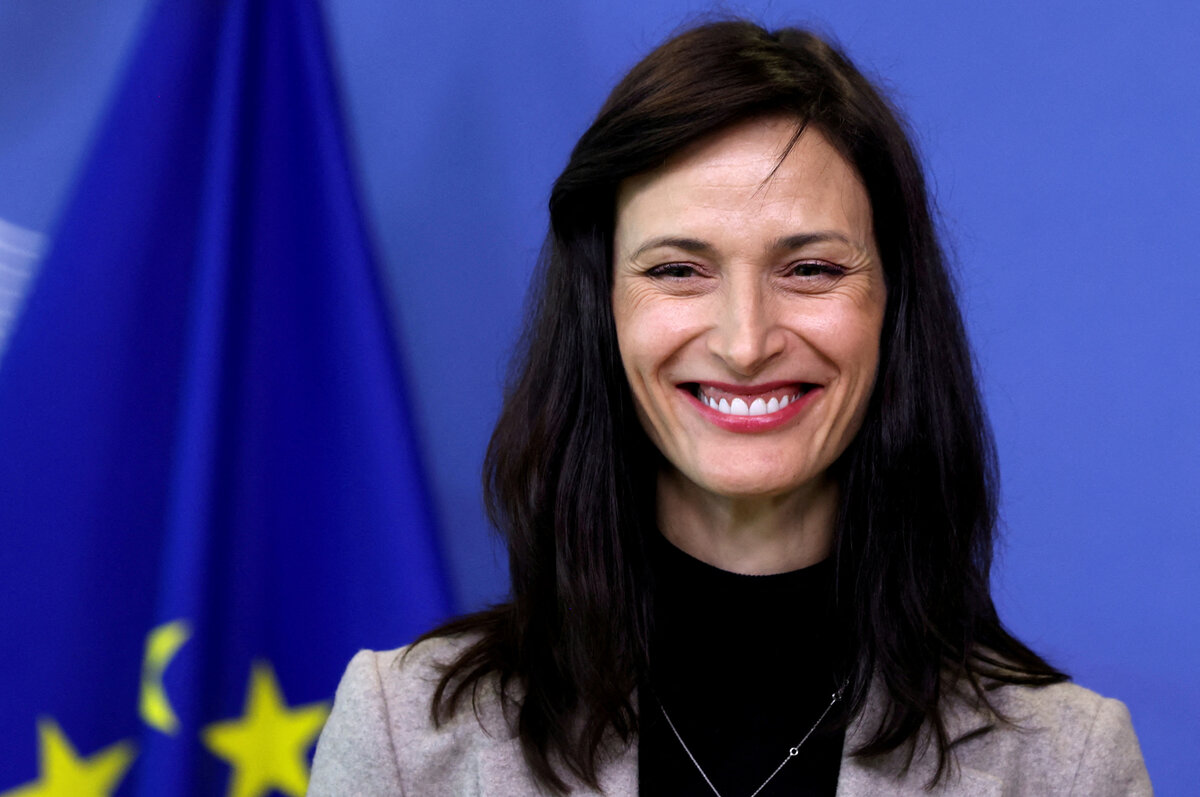
In personal income, Bulgaria ranks as the poorest country in the European Union. In civic spirit, however, the Black Sea nation may be displaying new wealth. Three years after mass protests for clean governance ended up felling a corrupt regime, the two largest parties agreed Monday to form a government that, according to reformist politician Kiril Petkov, will have “ministers who will work for Bulgaria without stealing.”
A rising sentiment among Bulgarians in favor of clean leadership – nearly 9 in 10 people see corruption as widespread – has yet to be reflected in many concrete reforms. Five elections in two years revealed the sticking power of a corrupt elite. To achieve political stability after the last election in April, the new government will employ a novel compromise: A leader of the anti-graft party, We Continue the Change, will be prime minister for nine months; then the center-right party long trying to appear to be anti-corruption, Citizens for European Development of Bulgaria (GERB), will hold the premiership.
The two parties are feeling pressure from more than voters. To join the eurozone or for its people to enjoy visa-free travel in the EU, Bulgaria needs to implement deep change, especially in ensuring an independent judiciary and accountability for the chief prosecutor. The EU is also withholding post-pandemic recovery funds until Bulgaria makes sure the money does not line the pockets of politicians.
Young people clearly want Bulgaria to be closer to the EU and its values. That helps explain why the GERB party chose Mariya Gabriel, the former European Commissioner in charge of tech innovation, as its candidate to be the second prime minister. She says the country needs leaders who “work so that the citizens have confidence in them.”
“The Bulgarian people,” writes Hugo Blewett-Mundy of the Center for European Policy Analysis, “have lost their patience with what they see as a state captured and controlled by an oligarchic mafia.” Their own shift in values – toward transparency and honesty in government – may now be front and center for a new set of leaders.

A Christian Science Perspective
Each weekday, the Monitor includes one clearly labeled religious article offering spiritual insight on contemporary issues, including the news. The publication – in its various forms – is produced for anyone who cares about the progress of the human endeavor around the world and seeks news reported with compassion, intelligence, and an essentially constructive lens. For many, that caring has religious roots. For many, it does not. The Monitor has always embraced both audiences. The Monitor is owned by a church – The First Church of Christ, Scientist, in Boston – whose founder was concerned with both the state of the world and the quality of available news.
Innocent of illness
- Quick Read
- Read or Listen ( 3 Min. )
-
By Mark Swinney
Sometimes it can seem that we’re nothing more than vulnerable mortals, susceptible to sickness and harm. But getting to know ourselves as God does – spiritual and pure – brings healing.
Innocent of illness
Often, guilt and innocence relate to the laws we are to obey as members of a society. But there’s also a different take on innocence that has relevance to our lives – one that opens the door to freedom from illness and torment. It stems from an idea that people were seeing more and more clearly even back in biblical days, with healing effect: that God’s infinitely powerful goodness is what truly governs, and this pure goodness is reflected in His children.
In our own era, this insightful facet to prayer still is effective. To understand how it can work, it’s helpful to step back and consider this question: Why has God judged us to be innocent?
Christian Science teaches that the purity of God, whom the Bible names Love and Spirit, is reflected naturally in all that God creates – including each of us as His children. It is Spirit’s doing that our true nature is spiritual, unencumbered by materiality and the evils associated with it.
Spirit ensures that its creation forever remains purely innocent and spiritual. You and I are not waiting for some future day to become God’s spiritual, innocent children. Despite what the physical senses indicate, this state of existence is the spiritual fact for us now and always.
Innocence is found in all of God’s immortal creation. The notion that God’s creation is subject to material limitations is simply a mistaken accusation. We aren’t obliged to bow to or fear such an unfounded verdict or the punishment that is supposed to come with it. In “Science and Health with Key to the Scriptures,” Mary Baker Eddy, the discoverer of Christian Science, says, “We have no trials for sickness before the tribunal of divine Spirit. There, Man is adjudged innocent of transgressing physical laws, because there are no such laws. Our statute is spiritual, our Government is divine” (pp. 441-442).
Consider what the world has accused us of. We’ve been accused of being created by a material process; of having physical weaknesses, flaws, and vulnerabilities; of being perpetual victims, susceptible to any and all evils.
But that’s not man, a term that refers to all of us in our true, spiritual identity as God’s children. The only “accusations” that can be true and have power over God’s offspring are those that are true about God, because God – infinitely good divine Spirit – is the one almighty authority. Man images forth the perfection and goodness of God – and only that. Accusations that we are anything less than how Spirit made us are groundless because God has destined us to remain forever Godlike.
Throughout Jesus’ ministry, he demonstrated how an understanding of everyone’s innocence, or purity, as God’s spiritual offspring brings healing. This applies to us, too. The Bible promises, “Now is come salvation, and strength, and the kingdom of our God, and the power of his Christ: for the accuser of our brethren is cast down” (Revelation 12:10).
At Christmastime one year, my wife found herself suffering from food poisoning. We prayed together, affirming her innocence as God’s child, in the spirit of these passages in Isaiah: “The Lord is exalted; for he dwelleth on high: he hath filled Zion with judgment and righteousness.... And the inhabitant shall not say, I am sick” (33:5, 24).
The more we prayed, the more clear it became that my wife, in her true nature as God’s child, wasn’t guilty of being a vulnerable mortal; she remained innocent, always expressing Spirit’s purity and wholeness. And the illness very quickly dissipated.
No matter what misconception about our real, spiritual identity we may have been accused of, God’s salvation and strength are here to acquit us. God loves us and constantly expresses innocence in us, and gives us the ability to recognize it. Always, God has found His children not guilty. It’s a joy to honor and live His verdict.

Viewfinder
Indian embrace

A look ahead
Thank you for joining us. Please come back tomorrow, which will mark one year since the school shooting in Uvalde, Texas. We’ll look at people there and elsewhere who have been moved by school shootings to become activists.
Also, a quick note: Yesterday’s intro on blues musician Otis Taylor contained an error about his race. He is Black.



